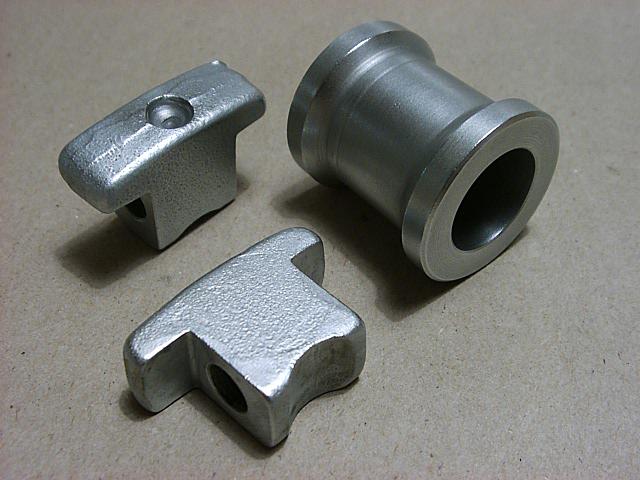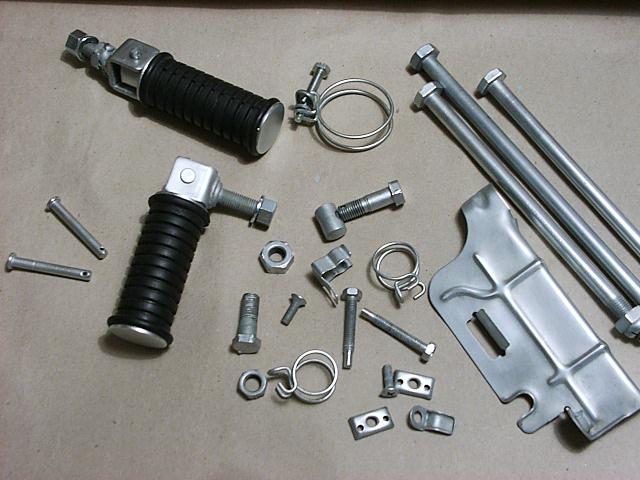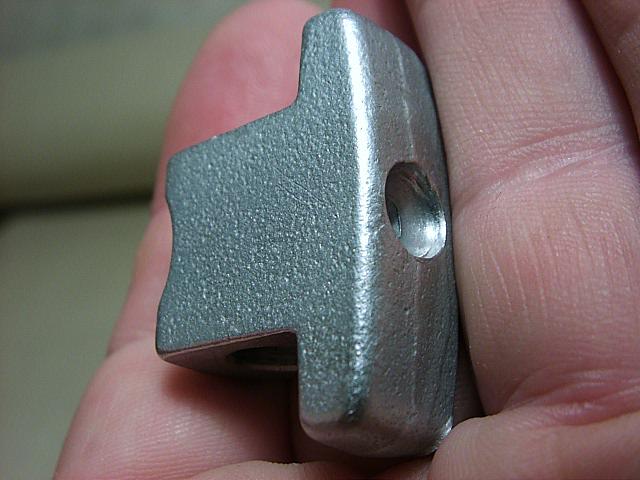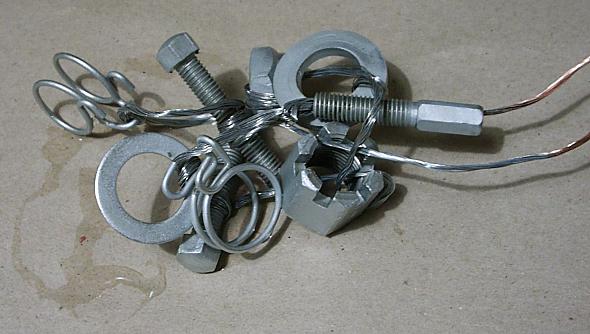![]() See the most recent zinc plating job for a Suzuki GT750L
!
See the most recent zinc plating job for a Suzuki GT750L
!
I got a Caswell plating kit (Copy Cad/Zinc), http://www.caswellplating.com/kits.htm
I was impressed by the items Ray Meyers had plated using an Eastwood kit. I began trying to improve on the bolts
of the chain adjusters and the oil pump cable adjuster.. Cheaper to buy new bolts ? Good point. I guess the motive
is mostly a desire to be able to do that kind of work when needed. Many times before I have sandblasted and spraypainted
hard-to-locate bolts in spray can silver wishing I could do better.
Here is my first impression from trying a zinc plating kit I got. It's a Caswell 'Copy Cad/Zinc' kit. Once you
know what's involved then really only the chemicals are the hard-to-get items. You could just as well find a plastic
bucket, heater, and power supply in your neighbourhood. But a kit gets you going so such a kit has it's place for
a beginner. The chemicals come as concentrate to be mixed with a gallon (4.5 litre) of distilled water. I found
4 litre bottles of distilled water at a near gas station. That water is heated before mixing, then allowed to cool
off. Ideal plating temp is up to 90 F (some 32 celsius) but normal room temp works too. A 100W aquarium heater
is included to warm the electrolyte when needed. Modest current is needed for small parts. A small DC power supply
is included, some 3V/200mA. Actually two came in the kit, one with U.S plug 110V, and one 220V with the giant U.K
connector.. I tried the 110V with a 220V transformer I have.A plate of pure zinc is included which you cut in half
and hang at each side of the plastic tank. The kit includes a degreaser chemical that is supposed to be mixed with
water and heated near boiling in a 2nd container. Parts are supposed to be cleaned in that fluid before plating
but I didn't use that at all. I used only sandblasting before plating. Parts are wired up on copper wire (at least
that's what I did) and submerged into the electrolyte. The plates are wired up and connected to the + lead. The
- lead is connected to copper wire onto which the item to be plated is submerged into the electrolyte solution.
I used a piece of wood above the tank to hang the wires from. Some 5-15 minutes is sufficient depending on desired
thickness. The kit also come with a 'brightener additive' which yields a brighter than otherwise appearance when
the parts are finally removed from the tank. Some dark spots may appear where the wires have touched the part but
these rub off easily with steel wool and the zinc seem to distribute everywhere.
Conclusion: Great ! I was surprised how easy it is to use, and the quality of the
result. Newer again any silver spray paint on bolts..
Any restorer should have a container of this fluid, a plate of zinc and a power supply. Hooks up quickly and the
fluid can be reused over and over and can be stored for years they say. Upon very frequent use the zinc plates
finally dissolve after their atoms have all been transferred over to plated items.. Once you know how it works
only the chemicals are really needed from a supplier like Caswell. Most people already own the rest of the items
needed or can find them in a shop nearby. But in my case I didn't have a clue about what was involved so the kit
did it for me. The kit include a comprehensive 'all-there-is-to-know-about-DIY plating' book but only a fraction
of it is needed for the zinc kit. It's a manual for all the variants of kits that Caswell sell and all sorts of
collections of articles associated with plating.
Their address is CASWELL, Inc., 4336 Route 31, Palmyra, NY 14522-9719, USA
The web site is http://www.caswellplating.com
The kit was fairly expensive, $99 at time of writing, but individual parts sums up as well. The vital chemical
is the copy cad/zinc solution, available separately at $40. They sell the included pure zinc plate separately at
$22. As with the earlier rectifier discussion, likely those of you who are chemists might roll on the floor laughing
out loud (ROTFLOL) at the prices and say hey I can mix that stuff up for a dollar! But what you are buying here
is that you don't have to do the research and trial-errors of a recipe yourself let alone finding a local source
for the ingredients.
I tried some more plating, restoring various GT mounting parts.Where the plating system
proves invaluable is for restoring the finish of GT specific items that are either no longer available or a bit
silly to buy new just for cosmethic reasons.
I found out the small power supply that comes with the kit plated very slowly in case of bigger parts, more current
neeed in that case. I found out an ordinary 12V battery charger worked well as a power source for bigger parts.
With the charger I connected a ordinary 12V double filament rear lamp bulb (those used in the GT rear lamp) in
series with the circuit as a resistor. This allows two 'power modes', using the brake filament of the bulb (stronger
light) gives more current suitable for bigger parts (about two amperes!), the other filament gives less current
for medium size parts. For smaller parts the small DC converter supplied worked fine. I didn't heat the electrolyte
at all, normal room temeperature works fine. Parts plate in 5-15 minutes. I used it inside the garage, not much
more funes noticeable than when charging a car battery. A good thing is that the electrolyte can be reused over
and over and stored for years. When the fluid level decreases due to evaporation just add more distilled water
to top up. The crystals will stay in there.



Various plated GT750 items.


Wired-up parts on copper wire pulled from the bath
(C)2001 Gunnar Forsgren, All rights reserved